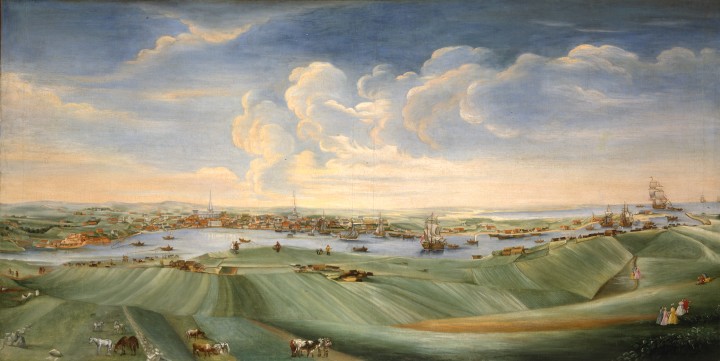Scottish Art News
Latest news
Magazine
News & Press
Publications
View of Aberdeen
By Lena Kammerer, 10.06.2025

Walking into Aberdeen Art Gallery’s exhibition View of Aberdeen is like stepping into a giant memory box, assembled not by a single artist but by a whole city. Housed in a single, modestly sized gallery room on the first floor, the exhibition, which has taken its title from William Mosman’s marvellous oil painting ‘View of Aberdeen’ (1756), also on display here, bursts at the seams with paintings, photographs, street signs, newspaper clippings, and other memorabilia, all drawn together by a single subject: Aberdeen itself. The concept of the exhibition is based on conversations with Aberdonians about ‘what Aberdeen means to them?’ - their responses shaping the selection of artworks and objects that now form this communal portrait of the city.
There is a vibrant eclecticism here, both in medium and mood. The space is packed with exhibits that span different times, styles, and viewpoints, giving a sense of the city’s many identities — past and present, personal and collective, gritty and tender. Nevertheless, each piece seems to speak to another, forming a kind of intimate, ongoing conversation about what Aberdeen was, what it is, and what it could be.
 View of Aberdeen installation images, courtesy of Aberdeen Art Gallery
View of Aberdeen installation images, courtesy of Aberdeen Art Gallery
Plastic seagulls hover overhead, placed high on top of exhibition cases — playful and faintly absurd, like guardians of the whole affair. They watch as we move from one exhibit to the next, casting mild judgment or silent encouragement. Their presence adds a layer of humour, nudging us not to take it all too seriously. It is that particular brand of Aberdonian humour — dry, unflashy, and fundamentally self-aware — that ties it all together. An evident, almost defiant pride runs through all the artworks and objects exhibited; not just in Aberdeen’s landmarks or its history, but in its everydayness. The presentation has something positively nostalgic, a kind of celebratory affection otherwise rarely associated with the grey-stoned city. One leaves with the reassuring sense that Aberdeen is, and always has been, quietly creative, quietly funny, and full of life.
Doric, the regional dialect, has been cleverly woven through the exhibition space. Most prominently, the four overarching themes, which simultaneously serve as vague associations with the objects and artworks arranged under them, are all familiar Doric sayings: ‘far I bide’ (where I live), ‘chavvin awa’ (working), ‘oot n aboot’ (out and about), and ‘weel kent’ (well known). For those who grew up in Aberdeen, these phrases may come with a smile of recognition; for those from elsewhere, they offer a kind of gateway into the local psyche; a
gentle education in its pride, humour and peculiarities.
Insights from residents are also scattered throughout, presented not as accompanying text but as essential components of the exhibits. These snippets, sometimes poetic, sometimes blunt, ground the exhibition in lived experience. They act as a bridge between the visual and the emotional, linking what we see with what we feel. This direct engagement with community voices is part of what gives View of Aberdeen its warmth and weight. It is not art about a city; it is art of the city.
In many ways, the exhibition feels like a successful example of a collaborative community effort. A democratic spirit to selection and curation is palpable, as if anyone could have contributed something. That openness helps explain the exhibition’s extensive emotional range. There are proud moments, funny ones, painful ones, and banal ones, all coexisting in a way that reflects the real texture of a city. It does not aim to be definitive; it is more like a scrapbook made by people who know Aberdeen deeply and love it for all its contradictions.
 View of Aberdeen installation images, courtesy of Aberdeen Art Gallery
View of Aberdeen installation images, courtesy of Aberdeen Art Gallery
Still, there is something a bit confined about the physical scope of the exhibition. With so much in a single room, it can feel like the city’s voice is shouting over itself to be heard. If anything, it is a testament to the strength of the concept that one immediately wants to see it expand – as it is planning to do. View of Aberdeen is not a finished product but a long-term project initiated by Aberdeen Art Gallery, described as seeking ‘to ensure more people see their lives represented in the collection’. With people’s reflection on the city’s past, present and future at its centre, the exhibition is meant to be added to and updated at regular intervals by encouraging people to contribute their view(s) of Aberdeen.
At its heart, View of Aberdeen succeeds because it does not try to mythologise the city. It does not sell a story of gritty resilience, industrial decline or windswept romance (though all of that is in there if you want to find it). Instead, it focuses on the human-scale details; the roller skates, the Tennents glass, the bakery sign, the photographs and paintings of the city and its people. The result is a warm, funny, sometimes aching portrait of a place made by and for the people who call it home. If art can help us see the familiar in new ways, then View of Aberdeen is a quiet triumph. And if nothing else, it is nice to feel some positivity about a place that, too often, is spoken of in greyscale. Here is to hoping the plastic seagulls will keep watch over an ever-growing and ever-changing compilation of exhibits.




